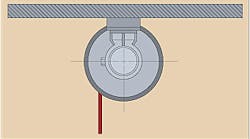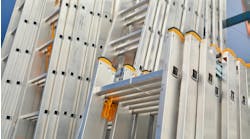The value of the cord reel has only increased as manufacturers have added more application-specific features
As every electrical worker knows, the cord reel is an important, if not essential, tool that safely and conveniently stores, pays out, and automatically rewinds electrical cable. Designed for a broad range of applications, cord reels are used to power mobile machinery from a stationary power source. Some inexpensive models are even used to provide portable lighting for those hard-to-see work areas. But do you really know what to look for when purchasing or specifying a cord reel? These tips should help you make the proper selection and get the most value out of your next purchase.
The reel drive system pays out and takes in the cable. With moving machinery, constant cable tension is required to automatically take up cable slack as the equipment moves. In other situations, cable can be pulled out to a desired length, locked, and retracted for storage when not in use.
Most cord reels are driven by wound steel springs. However, springs have physical limitations, so some manufacturers have introduced alternative drives that offer longer life and improved performance. For example, an electric gear motor is suitable for constant-speed travel, while an electrical torque motor is used for variable speed applications. Air-operated and fluid hydraulic motor drives are less common.
Cable wire size
Choose the size by calculating the total amperage required to operate the equipment it will supply.
Number of conductors.
All power supply applications should include a safety ground conductor. For example, single-phase systems require three conductors, and 3-phase applications require four conductors.
Type of cable.
Cable should be very flexible for reeling service and be protected by a neoprene jacket for oil resistance. Flexibility also ensures better performance in cold weather. The most commonly used types include 600V SOOW and 300V SJOOW. For safety reasons, most cords feature a high-visibility color. It's advisable to order the cable with the reel, along with any accessories your application requires, such as a handlamp, receptacle, or shock-absorbing stop ball. Reels equipped with cable are rated and shouldn't be used at voltages above the rating of the cable.
Application type.
A listing of potential applications include vertical lift, horizontal suspension, pick-up, vertical pick-up, retrieval, and lift-balance. Each requires a variation in spring tension for optimal performance.
Vertical lift applications call for a reel mounted on the ceiling, wall, or overhead structure where the entire cable length is vertically suspended. Spring tension must be capable of lifting and rewinding the fully extended cable (Fig. 1).
In horizontal suspension arrangements, the cord reel is mounted on the ceiling, wall, or overhead structure and the entire cable length is horizontally suspended (unsupported) between the reel and the equipment that's being supplied, such as a crane or hoist (Fig. 2).
In pick-up applications, the cord reel is mounted on a crane or other moving equipment and located about 3 ft to 6 ft above the floor or cable tray. Only a light spring tension is required to lift a short section of cable to the height of the drum (Fig. 3).
The term vertical pick-up refers to a cord reel mounted on top of a vertically moving machine where the reel moves vertically toward the power source. An extremely tight spring tension is necessary since all cable is being fed vertically into the reel, requiring the reel to do very little work (Fig. 4).
Also known as a “drag” application, retrieval applies to a stationary cord reel mounted at one end of machine travel. The cable is pulled off when the machine moves away from the reel. As the machine moves back toward the reel, strong spring tension is required to drag the cable back to the reel with sufficient speed before the machine overtakes the cable (Fig. 5).
Similar to the basic vertical lift application, the lift balance requires greater spring power to lift the accessory weight wired to the end of the cable (Fig. 6).
Cable outlets and swivel bases.
Cable outlets and swivel bases prevent unnecessary cable bending, twisting, and friction. There are four types of cable outlets: the guide rail, the four-roller outlet, the swivel outlet, and the two-roller outlet.
Guide rails.
Use a guide rail where in-line or slightly angular payout is involved. Guide rails stop cable from rubbing against the moving reel side, and prevent poor piling of cable (Fig. 7).
Swivel outlet
The swivel outlet allows the cable to make a 90° bend through the outlet. A bracket holds a larger roller that's separated from the bracket and mounts to the reel by a ball bearing. This design allows the upper bracket to swivel 360°. To prevent cable twisting, only use this outlet type for a payout arc up to 120°.
Two-roller outlet.
This type of outlet is generally used on a crane or traveling machine. It can be mounted to a ceiling or directly to the machine (Fig. 9).
For payout cable angles between 100° and 360°, a swivel base is recommended. Because the entire reel is mounted on the swivel base, it's free to rotate and follow the direction of cable payout to provide direct-line operation. Two types of swivel bases are available. The first, the limited swivel base, is used when direction of cable travel is in an arc ranging from 90° to 335°. The second design, the continuous swivel base, is used when the cord reel supplies power to a crane or hoist operating around a continuous 360° track.
As cord reel designs continue to evolve and become more complex, electrical contractors need to develop a better knowledge of the various designs and options available. This will allow them to choose the proper unit for a given application and ensure safe, productive results for them and their customers.
Walsh is director of marketing for EGS Electrical Group's ECM Division in Rosemont, Ill.



